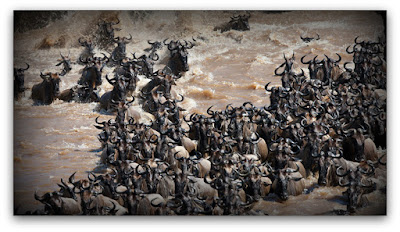Every year, two million wild animals make a great trek through one of the most spectacular landscapes in Africa. It's not too late to reserve your front-row seat for the greatest wildlife spectacle on the planet. Every year, around the end of the wet season in April, two million wild animals make a great trek through one of the most spectacular landscapes in Africa.
Breeding Season
The breeding season - a spectacle in itself - coincides with the transition from rainy to dry season, and by its end in July, the herds will have moved even further north and reached their greatest challenge: crossing the swollen Mara river in order to reach the green grass of the Masai Mara. The herds start arriving in the Masai Mara in early July, and by August the northward part of the trek is over. During October or November, the herds start moving again, retracing their tracks over 3000 km and through crocodile-infested rivers back to the Ngorongoro.
The Stars
About 1.5 million wildebeest, accompanied by 200,000 zebra, 20,000 eland and over 500,000 gazelle, will embark on this journey of thousands of kilometres.
The wildebeest (or white-bearded gnu) is the dominant herbivore in the Serengeti ecosystem, and lead player in the spectacle. During the annual breeding season, over a period of 3 to 6 weeks just before the start of the final northward cycle of the migration, the plains are filled with the sounds of rutting and fighting. Thousands of territorial bull wildebeest fight off bachelor bulls and mount as many females as they can. They put on a great half-time diversion, and ensure their species' survival by impregnating as many as half a million females. The females will provide an exciting finale when they calve eight and a half months later, as the migration completes the circular route and returns to the Ngorongoro.
The Bit-Players
Wildebeest, zebra, eland and gazelle are not the only animals which make an appearance in this wildlife spectacle. While they aren't present in such huge numbers, the open, grassy, almost treeless plains of the Serengeti ecosystem are also home to giraffe, elephant, ratels, zorilla, kori bustards and ostriches.
The Villains
Three thousand lion and numerous cheetah and leopard, supported by packs of African hunting dogs and hyena, prey on the great herds. Crocodiles lie in wait in muddy river waters. Subplots of lion hunts and leopard stalkings, hunting dog ambushes and hyenas brawling with scavenging vultures, add dramatic interludes to the great migration.
The Locations
Ngorongoro, Serengeti, Masai Mara: the names are synonymous with the greatest wildlife experiences Africa has to offer. The Serengeti ecosystem spans the international boundary between Tanzania and Kenya in east Africa and covers an area of approximately 27000 square kilometres, 15,000 of which are within the boundaries of national parks, conservation areas, game reserves and hunting preserves.
Samet Bilir writes about technology trends, digital camera reviews, and photography, such as high end digital cameras. To read more articles from him visit his website here.
Zemanta Related Articles




















